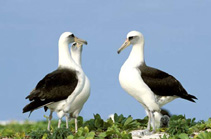Phoebastria immutabilis (Rothschild, 1893)
Laysan albatrossWarning: DOMDocument::load(): SSL operation failed with code 1. OpenSSL Error messages: error:140770FC:SSL routines:SSL23_GET_SERVER_HELLO:unknown protocol in C:\Apache24\htdocs\includes\SpeciesSummary.lib.php on line 1236
Warning: DOMDocument::load(): Failed to enable crypto in C:\Apache24\htdocs\includes\SpeciesSummary.lib.php on line 1236
Warning: DOMDocument::load(https://sealifebase.nrm.se/webservice/AquaMaps/getAMap.php?genus=Phoebastria&species=immutabilis): failed to open stream: operation failed in C:\Apache24\htdocs\includes\SpeciesSummary.lib.php on line 1236
Warning: DOMDocument::load(): I/O warning : failed to load external entity "https://sealifebase.nrm.se/webservice/AquaMaps/getAMap.php?genus=Phoebastria&species=immutabilis" in C:\Apache24\htdocs\includes\SpeciesSummary.lib.php on line 1236
Classification / Names Common names | Synonyms | CoL | ITIS | WoRMS
| Procellariiformes | Diomedeidae
Environment: milieu / climate zone / depth range / distribution range Écologie
. Tropical
Distribution Pays | Zones FAO | Écosystèmes | Occurrences | Introductions
Pacific Ocean and Western Central Atlantic.
Length at first maturity / Taille / Poids / Âge
Maturity: Lm ? range ? - ? cm Max length : 81.0 cm TL mâle / non sexé; (Ref. 8812); poids max. publié: 2.9 kg (Ref. 356)
Description synthétique Morphologie
Wing: 20.3 cm.
Total Length: 79 to 89 cm (Ref. 8812). Total annual breeding population of some 362,000 pairs representing about 1,200,000 to 1,400,000 birds (Ref. 84934). Occurs over open ocean (Refs. 356, 122680). Mainly feeds at night and often far from breeding colony. Forages with conspecifics, but rarely with other species. Seizes prey from the surface while sitting on the water. Scavenges on carrion and follows fishing boats. Diet consists mainly of squid as well as deep-water crustaceans, fish and flyingfish eggs (Ref. 122680).
Life cycle and mating behavior Maturité | Reproduction | Frai | Œufs | Fécondité | Larves
Breeding birds arrive at the islands in the first week of November, egg laying starts late November to early December. Eggs start to hatch in late January to early February, and by the second week of August all birds have fled the island (Ref. 96995).
Référence principale
Références | Coordinateur | Collaborateurs
Lepage, D. 2007. (Ref. 7816)
Statut dans la liste rouge de l'IUCN (Ref. 130435)
Quasi-menacé (NT) (A4bd); Date assessed: 07 August 2018
statut CITES (Ref. 108899)
Not Evaluated
CMS (Ref. 116361)
Not Evaluated
Menace pour l'homme
Utilisations par l'homme
| FishSource |
Outils
Plus d'informations
Pays
Zones FAO
Écosystèmes
Occurrences
Introductions
Stocks
Écologie
Régime alimentaire
Éléments du régime alimentaire
Zones FAO
Écosystèmes
Occurrences
Introductions
Stocks
Écologie
Régime alimentaire
Éléments du régime alimentaire
Sources Internet
BHL | BOLD Systems | CISTI | DiscoverLife | FAO(Publication : search) | Fishipedia | GenBank (genome, nucleotide) | GloBI | Gomexsi | Google Books | Google Scholar | Google | PubMed | Arbre de Vie | Wikipedia (Go, chercher) | Zoological Record
Estimates based on models
Catégorie de prix
(Ref. 80766):
Unknown.



